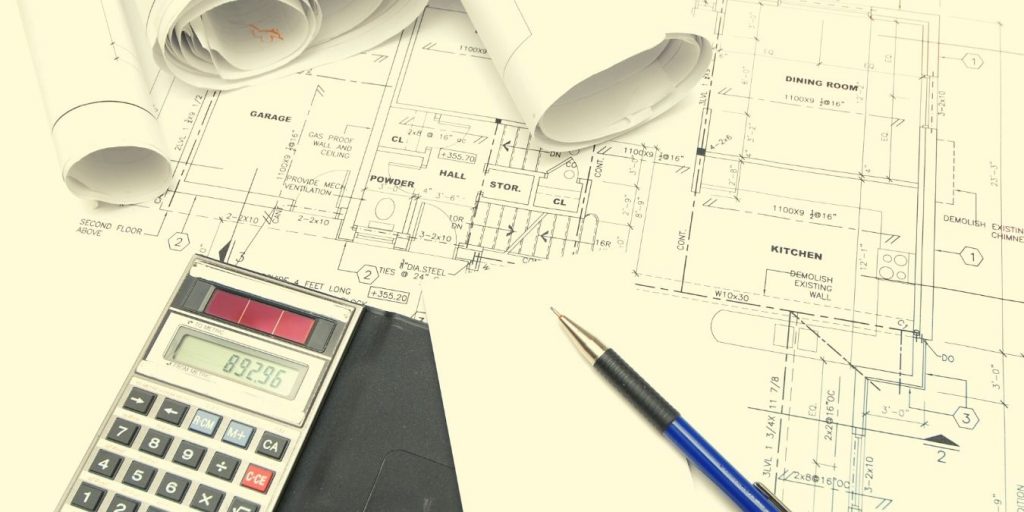One of the significant challenges in the construction industry is managing projects with unique requirements and features. However, all projects have the same primary elements such as scope, schedule, and budget. The accuracy of the cost estimation process determines how smoothly a project will run.
Table of Contents
What is construction cost estimating?
Construction cost estimating is a foundational principle in forecasting the cost of construction of a structure. Project owners also use construction cost estimation to determine a project’s feasibility, scope, and the necessary budget allocations. Proper construction estimation practices prevent the contractor from losing money and the client from overpaying.
Why is estimating important?
It is practically impossible for the initial construction estimate to match the final project cost. However, this does not negate the usefulness of a comprehensive construction estimate.
Estimating assists:
- Project owners in determining the suitability and feasibility of a project
- The builder’s ability to decide on the profit potential of a project.
- The procurement team with the financing of the project.
- The project team’s ability to make vital decisions on the design or materials could positively or negatively impact the project’s cost.
The concepts that a cost estimator considers affect the total cost of the project.
Therefore, it is imperative to have a set of data points that a cost estimator should investigate. These factors include materials, location, machinery, and labor. These are the apparent factors, but the estimator should also consider hidden factors such as the possible market fluctuations that affect the costs of materials. Estimators also need to assess the project-specific materials as an eco-friendly building would need different materials than an ordinary building.
What are the benefits of cost estimating in construction?
Cost estimation provides the foundation for the planning of a job schedule. The accuracy of an estimate determines whether a job meets its objectives or not. Some of the benefits in cost estimation include:
- Accurate Planning: Proper cost estimation enables one to plan the subtasks required to complete a task correctly. You can develop a work breakdown structure more efficiently and ensure your project team adheres to the project timelines.
- Increased profit margins: Poor planning and unexpected events make it impossible to finish the job on time and within budget. However, proper estimating helps one account for both expected and unexpected costs, thus protecting profit margins.
- Management of resources: With an insight into the tasks and timelines at hand, this can ensure you have the skills to identify resource gaps, hire people as needed and take on projects with confidence.
- Better reputation: Proper planning helps a builder finish the projects on time and budget. This fosters stronger relations with the client and wins the builder repeat business.

Who creates cost estimates?
Construction estimators produce and revise estimates for a project. They are familiar with the design and expenses incurred in the project. They’ll also create multiple assessments on the pre-design and design phase. With each design phase, the estimates become more accurate.
During the creation of estimates, the contractor oversees the link between the budget and schedule.

The cost estimating process
All projects benefit significantly from following a deliberate and thoughtful process in cost estimation. The cost estimating process requires good judgment and planning to achieve the best results from a project. One needs to have a basic understanding of the construction process to understand the cost estimation process properly. The following steps provide a guideline when making a construction estimate.
1. Agree on the cost estimating basis
The parties involved must agree based on cost estimation of the project before starting the estimation process. This activity entails obtaining project information such as previously developed scopes and schedules from which the estimator can come up with cost estimates. The level of the scope is always dependent on the project type, complexity, design matrix, and criteria. The cost estimator should clearly outline and document all assumptions in this stage. The cost estimator should also record additional and subsequent information to give a traceable history for each of the estimates made.
2. Base estimate preparation
A base estimate covers all the estimated costs of a project apart from the foreseen future escalations. These estimates are usually calculated depending on different techniques such as scope definition, size, and complexity of a project. In contrast, detailed estimates vary depending on the development phase of the project.
More details come to light giving a more detailed cost estimate as the design progresses. The critical inputs required in this stage are scope details, inflation rates, material take-offs, unit cost databases, and market conditions. The construction take-offs give the client an outline of the necessary material costs. Construction take-offs vary depending on the project’s size and scope.
Collecting and interpreting all scope documents can be challenging, but the project team must fix the scope documentation from the start to estimate the direct costs.
The cost estimator also notes all the cautionary notes, assumptions, and exclusions while preparing the base estimate. The estimate can also be attached and included as an attachment for reference for the remaining project activities.
3. Reviewing Base Estimate
Reviewing the base estimate is necessary to ensure all the assumptions and basis of a project are correct. It also means that all the base cost estimates are an actual reflection of the scope of work and schedule.
It prevents the double counting of items and ensures components are not missing. This stage reviews cost-based estimates and historical data or project-specific conditions by applying the necessary location and productivity factors. The estimator also checks indirect and overhead costs with the direct costs as the basis.
4. Risks and Contingencies
An integral part of project planning is developing a risk and contingency plan. Risk management is always an ongoing process for maximizing the possibilities of opportunities and minimizing the probabilities of threats. In addition, the estimator needs to include the cost impacts of hazards in the total project costs.
5. Outline a communication approach
Cost estimators should communicate the cost estimate data to all the necessary parties. A good communication approach determines the information that should be shared and who should receive the information.
It also determines the information channels that information should pass through. Thus, communication is just as important as numbers, and the information can be used as an effective critical tool to ensure the project’s success.
6. Peer review
Another construction estimator should always review a cost estimate. They perform spot checks to verify quantities and costs and check the scope completeness of a project. Peer review is a crucial phase for addressing significant gaps in the estimate and an opportunity to reduce costs. Assumptions are also removed and clarified at this stage.
After this review, the estimator can now present the estimate to the management for approval. Finally, the revised estimates are reviewed by the project management staff and incorporated into the project cost baselines.
Throughout the project, the estimator continuously updates the information; they are never done with estimating the project outcome.
Estimating is always a continuous process.
How to improve estimate accuracy
Inaccurate construction estimates are detrimental to the job in that you can quickly lose a bid, or you can win one but lose money throughout the construction process. However, there are some tips you can employ to have accurate and growing construction estimates. Below are some of the information you can use to improve your accuracy in cost estimation.
1. Develop a template for every job
Developing a template ensures that you do not leave out anything when developing a construction estimate. Templates include all line items that are within the scope of work of the project. For example, for some subcontractors, a template can consist of materials and labor. On the other hand, the electrician’s or plumber’s template includes more items such as fixtures, controls, and transmissions. The template can also include insurance limits and administrative costs.
Depending on the project, items can then be added or removed from the template.
2. Reviewing past projects
A review of past projects is very educational when it comes to putting up proposals. We can learn from past mistakes that help make our estimates accurate. A project of a similar size and scope is likely to have a similar construction estimate. Of course, no two projects are the same but breaking down the construction job costs enables you to evaluate the calculations more accurately. Continual improvement is impossible if you do not look where you started from.
3. Accurate takeoffs
The more accurate your take-offs are, the better your construction estimates. You can use take-off software to improve the accuracy of your take-off without having to print anything. As a result, you can determine areas and lengths more accurately within much less time. You can also break down your project into a work breakdown structure, ensuring that your project is not missing any major components. Do not, however, count every screw in the project. Instead, stick to the big stuff that matters.
4. Check your labor costs
Labor costs are one of the most expensive costs in a project. To make money, you need to know how productive your crew is and their completion time. Labor costs are not just the hourly wages, but they also entail the labor burden to the company. They can be summed up in indirect costs such as retirement, union contributions, tools, benefits, and more. A comprehensive labor rate sums up all these expenses.
Even in the best of conditions, no two people work at the same rate. Therefore, when calculating the labor rate, you should also factor in the weather conditions, skill rate, training, and personal issues. This way, you will accurately predict the person-hours required for the project and factor it into your cost estimate.
5. Countercheck subcontractor proposals
Subcontractors in a project bid for different jobs, and you, therefore, need to dig through the proposals and see what is included and what is not. Sometimes subcontractors may miss part of their scope or omit it altogether.
After skimming through the bids, you can then choose the best offer for the project. Checking other proposals is an excellent way to counter-check subcontractors’ work and ensure they do not overquote the price.
6. Check your formulas
Nothing is more embarrassing than preparing a reasonable cost estimate yet riddled with mathematical errors. Check formulas on the spreadsheet or software before submitting your bids. The minor errors in calculation can accumulate into huge sums and ruin the entire estimation process.

How to estimate construction costs
Estimating construction costs is one of the most important yet most neglected stages in construction. It is time-consuming, and the myriad of activities involved in construction leads many to neglect the exercise.
Methods of estimating construction costs
There are different ways of estimating construction costs, as we will discuss below.
Unit cost estimating
Unit cost estimating is a quick, easy and clean way of estimating construction costs. Cost estimators assign a unit cost to each component of the construction process. Setting the unit prices refines the process over time, as you can alter and modify subsequent projects for better estimates.
Stick estimation
Stick estimation is a prevalent method in cost estimation but also relatively cumbersome. One uses this method by listing every single possible cost on the job. It is an accurate estimation method but very time-consuming.
Empirical cost inferencing method
This method uses statistics and regression models to determine a project’s cost. It is, however, not recommended if you do not know how to use this method. It would help if you had someone on your team that explicitly does this.
Production Function
Production function relates the amount built to factors such as labor and materials. To achieve a given output, you must look for the optimal input. It can be pretty accurate in estimating the input and output relations of projects.
The five-level system of estimate accuracy
The accuracy of cost estimates is pegged upon the well-defined project plans in the design phases. The American Society of Professional Estimators subdivided the system into a five-level system that improves over time and is very reliable. The five-level system is subdivided as follows:-
Level 1: Order of Magnitude Estimate
This is made before the project takes off and is only used to determine a project’s feasibility.
Level 2: Schematic Design Estimate
This is the estimate produced in line with the schematic design.
Level 3: Design Development Estimate
This is the estimate in the design development phase
Level 4: Construction Document Estimate
This is the estimate that is taken off from construction specifications and drawings.
Level 5: Bid Estimate
This is the estimate based on the construction documents by the prices offered to the client.
A simplified approach
There is a more straightforward method of classifying the costs that groups the estimates into just three categories. These are design estimates, bid estimates, and control estimates. The names reflect the usage of the estimates.
Design Estimates
These are the estimates prepared during the design phase of a project. They start with the order of magnitude to determine a project’s feasibility. There are then the preliminary and conceptual estimates that are purely based on the schematic design. Then follows the detailed estimate from design development and lastly, the engineer’s estimate taken off from construction documents.
Bid Estimates
These are the estimates prepared by contractors during bidding as they look for data points such as direct costs, supervision costs, and other hidden costs to prepare their estimates.
Control estimates
This estimate is prepared after the contractor gets into a contract with a client and before construction starts. This way, contractors can plan for the upcoming costs.
What goes into your estimate?
There are many models in the industry that determine what goes into a construction estimate. However, at an abstract level, all estimates can be divided into three. These are:
- Labor
- Materials
- Overheads and Profits
Other professionals group the construction costs into Direct costs, indirect costs, and markups. For example, labor and materials are direct costs, while overheads and profits are markups.
The cost of materials is a direct cost, and it fluctuates depending on the demand and supply in the market. Equipment costs are also a direct cost, and a lot needs to be considered while computing these costs. For example, you need to consider transportation costs, equipment capacity, and renting costs of the contractor.
Indirect costs include temporary utilities, design fees, and mobilization of equipment and office support staff.
Tools to help you estimate
Construction estimators use different tools in estimation. Old school estimators use spreadsheet software like Excel. However, new construction estimating software is now available in the market that leaps into the future.
Construction estimating software streamlines the estimation process in both simple and complex projects. There is a narrow margin of human error, and good usability gives an analysis on cost and reporting.
The ease of use of software makes it easy to submit bids speedily and with efficiency. In addition, you can use cost estimating software like Proest that helps you estimate costs, track your spending and your bids. Our ROI calculator can also calculate how beneficial moving to estimating software could be for your business.
Cost estimating glossary
There are essential terms and concepts in cost estimation. However, there is a large degree of overlap between some of them.
- Takeoff: This is developed during the project preconstruction stage and measures the materials and labor necessary for project completion.
- Person-hour: This is a unit of work done by a person in an hour
- Labor rate: This is the amount of money paid to skilled artisans in an hour.
- Equipment costs: This refers to buying, renting equipment, or running costs necessary in a project.
- Indirect costs: These are costs not directly linked to construction work. They include transport, administrative, and other more minor expenses.
- Profits: This is the margin the contractor adds to the project cost as the profit.
- Escalation: This refers to the natural inflation costs with time.
- Bonds: This is a guarantee of delivery. If the contractor fails to deliver the project as per the contract terms, the owner is entitled to compensation. This compensation is as stipulated by the performance bond.
- Contingencies: This is a predetermined sum of money added to the cost estimate to cater for unforeseeable circumstances such as adverse weather conditions or material wastage.
- Capital costs: These are the initial costs for establishing a project, such as land acquisition, feasibility studies, design phase, and construction costs on materials, labor, and equipment.
- Operations and maintenance: These are costs for the day-to-day operations such as land rent, salaries, renovation costs, and maintenance costs.
Common mistakes to avoid
Inaccuracy in cost estimation is often a very costly mistake that results in cost overruns and blowouts in the schedule. Some of the common errors are as follows.
Improper estimation of labor costs
Labor costs are some of the most expensive yet the most difficult to estimate. Using a simple hourly rate in the labor rate can lead to huge variations. Therefore, you need to be as detailed as possible when calculating labor rates, factor in the overtime, and source data from similar projects for better accuracy.
Failure in factoring risks and contingencies
Cost variations are common when an estimator fails to factor in the risks. The higher the probability of a threat is, the more detailed the risk analysis should be. The experienced cost estimators assess the risks and determine whether a project is feasible for their firm or not.
Omitting some costs in the estimation
Overlooking some costs in estimation means that the profit margin will eventually take a big hit. Once one gets into a contract without revising these costs, the chances are that it will be impossible to recover the losses. One, therefore, needs a detailed estimation template that is standardized and cuts across all jobs. This way, the margin of error is minimized, and you can apply the template for future jobs.
Lack of thorough auditing
Sometimes the estimation may be okay, but a poor review of the numbers can lead to costly mistakes. In addition, time pressures can lead to errors in maths and measurements, which is why you need a standardized estimating template to help you compare and estimate correctly.

Frequently asked questions
Is construction estimating hard?
Construction estimating is one of the complex tasks you can embark on in construction. It is also crucial you base profits on how accurate estimates are. However, with the proper tools in estimation, the process is easier and more efficient.
Is estimating stressful?
Cost estimation can be stressful as it requires technical and analytical inputs and seeks a form of subjective judgment from the estimators. On the other hand, experienced estimators have developed problem-solving skills that help them adjust to the stresses associated with estimation. Estimating tools make work easier and lower the burdens on the estimators.
Conclusion
The road to accurate estimation takes time and patience and is vital in any project management role. First, one needs to know the basics of estimating and investing in the proper resources as it determines a business’s success or failure. Accurate estimation inhibits the likelihood of catastrophic financial outcomes in a project.

